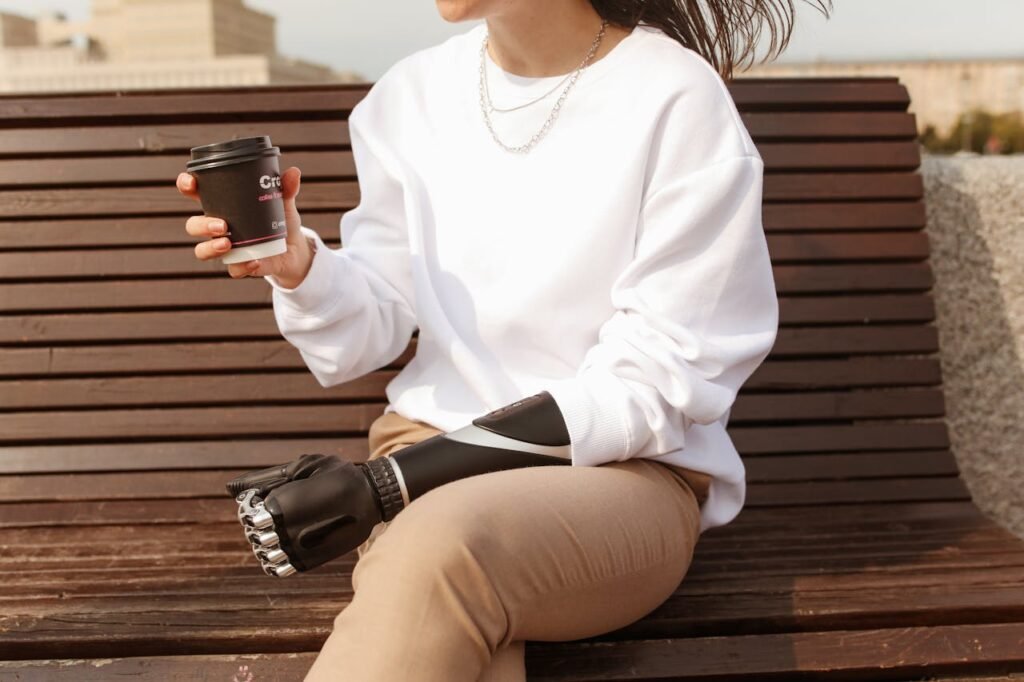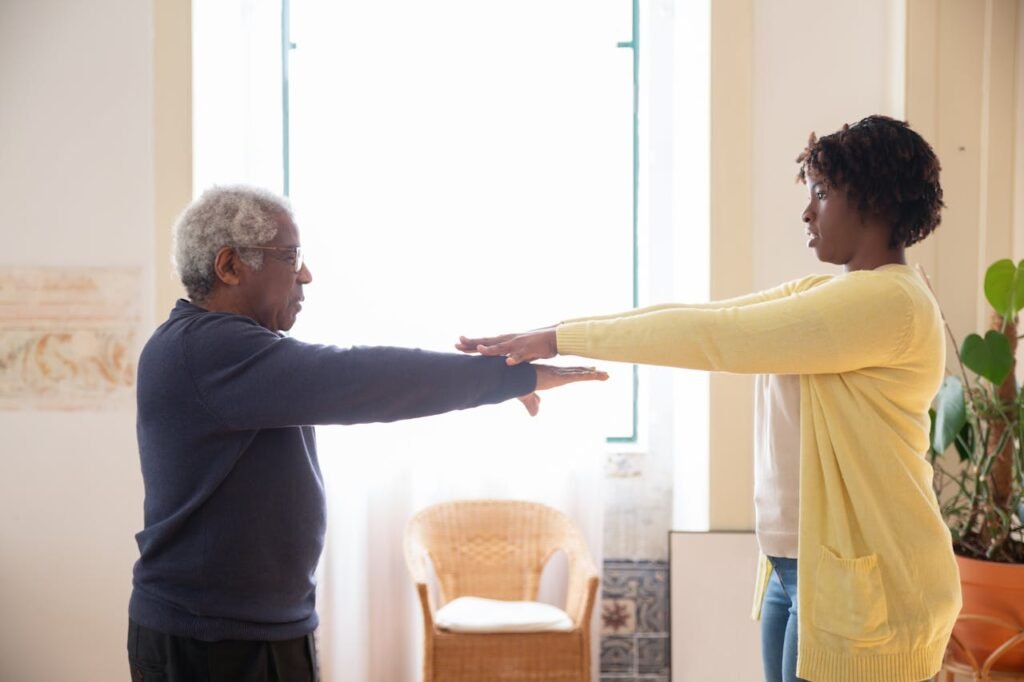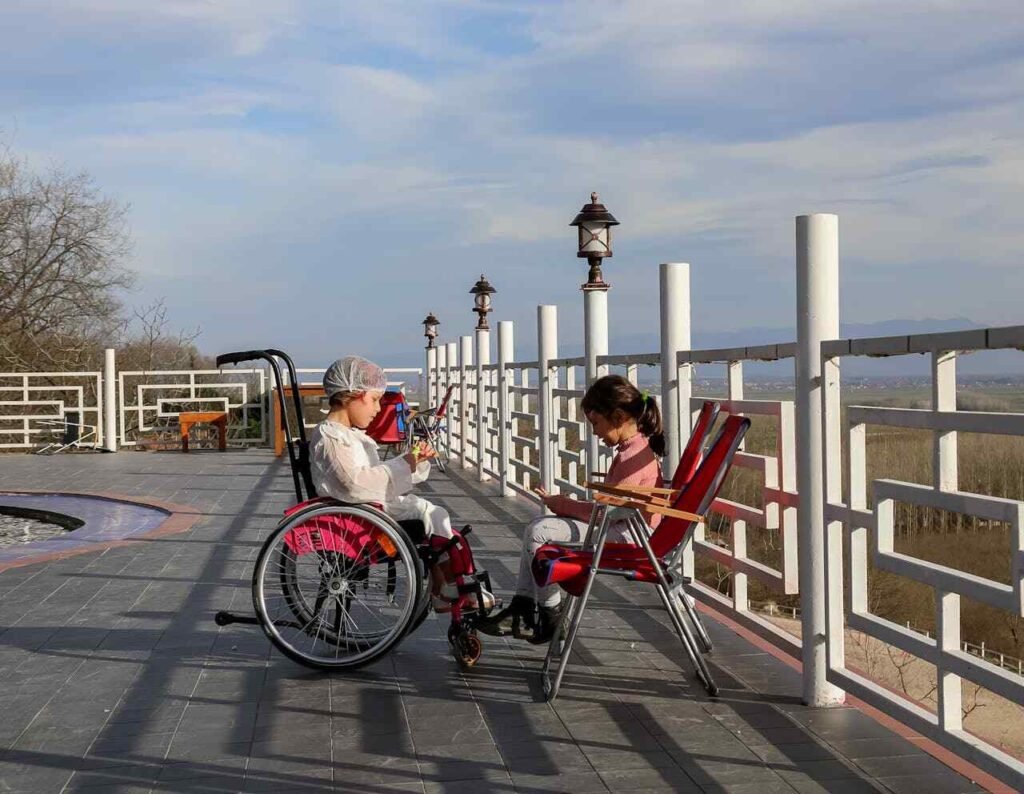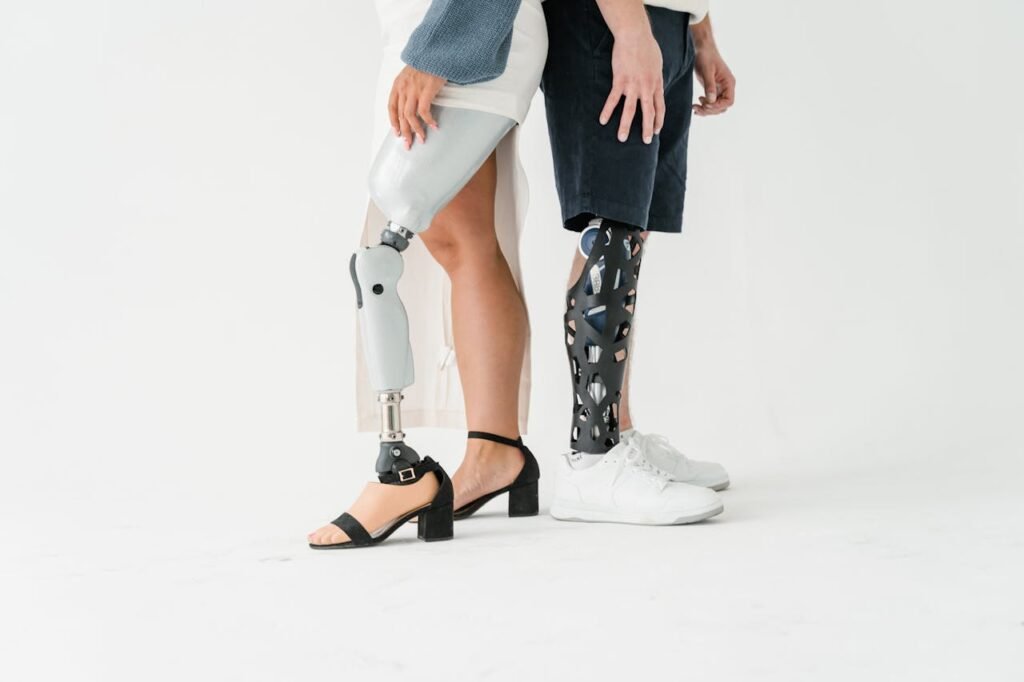Every time someone learns to use a bionic hand, something magical happens inside their brain. It’s not just the technology that adapts to them — their brain adapts too. That ability of the brain to change and grow? It’s called neuroplasticity. And it’s changing everything we know about prosthetics.
At Robobionics, we’ve seen it happen again and again. Someone walks into a demo, unsure if this device will work for them. A few sessions later, they’re picking up a pencil, pouring water into a glass, or giving a thumbs-up — not just because the bionic hand is smart, but because their brain is even smarter.
Let’s take a deep look at how neuroplasticity makes this possible. And why this simple idea — that the brain can change — is shaping the future of bionic limbs.
What Is Neuroplasticity?
Your Brain, Rewired

Neuroplasticity is your brain’s way of adapting. It means your brain isn’t fixed. It can build new paths, change old ones, and learn new things. This is how we remember songs, pick up new habits, or bounce back after an injury.
For someone who’s lost a limb, neuroplasticity becomes very important. When the brain no longer gets signals from that hand or arm, it doesn’t shut down. It starts to rewire. It looks for new ways to send and receive signals — sometimes from the muscles near the missing limb.
This is exactly what myoelectric bionics like Grippy™ tap into. By using muscle signals from the remaining part of the arm, Grippy lets users control their new hand just by thinking about movement. The brain learns. The body follows. The result is life-changing.
How Does This Work with Bionic Hands?
From Thought to Action
When you first get a bionic hand like Grippy™, it feels strange. You look at it. You want to move it. But nothing happens — not right away. That’s okay.
This is where neuroplasticity begins to show up. The brain starts to form new connections. It realizes, “When I send a signal to that muscle, the hand opens.” You try again. This time, the hand responds a bit faster. You feel more in control. The brain remembers that success. It strengthens the path. Soon, it becomes natural.
This is not science fiction. It’s real. And it’s powered by practice, feedback, and most of all — belief.
Grippy™ helps this learning process by giving real-time feedback through its Sense of Touch™ technology. When you pick up an object, Grippy lets you feel how hard you’re squeezing. Your brain takes that feedback, adjusts, and remembers. Day by day, the control gets better.
The Role of Muscle Memory
Small Movements, Big Impact
Muscle memory isn’t just for athletes or musicians. It’s something we all use every day. Typing, brushing teeth, tying a shoelace — once you learn, you don’t even think about it.
The same thing happens with bionic hands. At first, you concentrate hard just to make the hand open or close. But after enough practice, your body starts to remember. You stop thinking so much. You just do it.
This muscle memory works hand-in-hand with neuroplasticity. The brain forms the path. The muscles follow that path again and again. With time, it becomes automatic. And that’s when real freedom begins.
The Emotional Side of Relearning
Healing the Mind and Body Together
Losing a limb is not just physical. It affects how you feel about yourself. Many people feel like they’ve lost a part of who they are. That’s why regaining control through a bionic hand is about more than movement — it’s about confidence.
When someone learns to use Grippy™ and starts doing things again on their own, their mindset changes. They smile more. They stand taller. They feel strong.
Neuroplasticity helps with that too. It doesn’t just rebuild movement — it rebuilds hope. As the brain forms new paths, it also starts to let go of old pain, frustration, and doubt. The person begins to believe: “I can do this.”
And they can.
Training the Brain to Work with Tech
Simple Exercises, Powerful Results
Using a bionic hand isn’t about strength. It’s about signals. And the best way to train those signals is through small, clear tasks done over and over.
That’s why Robobionics offers guided rehabilitation. We even created a Gamified Rehab App to make it fun. When training feels like play, people practice more. And the more they practice, the faster the brain learns.
These exercises focus on muscle control, timing, and feedback. They guide the brain step by step — building strong, clear connections that make bionic control feel smooth and natural.
It’s not about rushing. It’s about steady, thoughtful progress.
Every Brain Is Different
Personalized Pathways

One of the best things about neuroplasticity is that it works for everyone — but not always in the same way. Some people pick up control fast. Others take more time. That’s normal.
At Robobionics, we customize every fitting and training plan to match the person. We look at their muscle signals, their goals, their lifestyle — and we adapt.
Neuroplasticity gives us that flexibility. The brain isn’t stuck. It’s always listening, always learning. So even if someone struggled with older prosthetics, they often find success with Grippy™.
Because Grippy isn’t just smart. It works with your brain, not against it.
When the Brain Meets Technology
A Natural Partnership
In the past, prosthetic hands were mechanical. You had to move your shoulder or body in a certain way to get them to open or close. It worked, but it didn’t feel natural. The brain wasn’t really involved in the same way it is with myoelectric bionics.
Today, things are different. The bionic hand and the brain work together. They talk to each other through tiny muscle signals. This is a huge step forward.
When you think about picking up a cup, your brain sends a signal down your arm. Even if your hand is gone, the muscle near your elbow still gets that signal. The sensors in Grippy™ pick it up, and the hand moves. It’s smooth. It’s fast. And it feels like part of you.
That’s the power of combining neuroplasticity with smart tech. It’s not just a tool. It’s an extension of your mind.
How Sense of Touch™ Changes the Game
Feeling Your Way Back to Control
One of the hardest things about early bionic hands was that you couldn’t tell how much pressure you were using. You might crush a paper cup or drop your phone without meaning to. There was no feedback.
That’s why Robobionics built Sense of Touch™ into Grippy™. It gives you a way to feel again.
When you grip something with Grippy™, sensors measure the pressure. That information is sent back to your arm in a way your brain can understand. You learn to “feel” with the bionic hand — not in the same way as before, but in a way that your brain can work with.
Over time, this feedback loop helps you make better, more careful movements. You grip just enough. You start doing delicate tasks, like holding an egg or zipping up a jacket. It’s amazing what happens when your brain gets the right information.
Small Wins Build Big Confidence
Rewiring Through Routine
Neuroplasticity doesn’t need big, fancy steps. It grows through small wins. The first time you open the hand. The first time you lift a bottle. These moments matter.
Each success tells your brain, “Yes, this works.” That feeling of success builds confidence. And confidence makes you try again. That’s the loop. The more you succeed, the more your brain builds new pathways. The more pathways, the easier it gets.
This is why daily routines and practice sessions are so important. You don’t need to train for hours. Even a few minutes a day helps. Grippy™ is designed to be lightweight and comfortable, so you can wear it often. And the more you wear it, the faster your brain learns.
Age Doesn’t Limit Neuroplasticity
The Brain Never Stops Learning
Many people think neuroplasticity only works in kids or young adults. That’s not true. The brain keeps changing throughout life.
We’ve seen users of all ages adapt to Grippy™. Some are young students. Some are working adults. Others are seniors. The key isn’t age — it’s attitude.
If you’re open to learning, your brain will respond. You may need more practice or more time, but you can still build new connections. And every connection brings more control.
This is why we always encourage people to try, no matter their age or background. Your brain is more powerful than you think.
Phantom Limbs and the Brain’s Memory
Understanding What’s Still There
Many people who lose a limb still feel it. This is called a phantom limb. It might seem strange, but it actually shows how deeply the brain holds on to the idea of your body.
The brain map for your missing hand is still there. It hasn’t gone away. That’s good news — because it means you can use that map to control a bionic hand.
When you start using Grippy™, your brain slowly shifts the old map. It connects those thoughts to the bionic hand instead. You think about moving your fingers — and now the bionic fingers move. It’s a powerful way to bring control back.
This is another reason why Grippy™ works so well. It respects the brain’s memory. It gives your mind a new way to reach an old goal.
Why Indian Innovation Matters
Building for Real Life
Imported bionic hands are often built for very different lifestyles. They’re expensive, hard to repair, and not designed for everyday Indian use. That’s where Robobionics is different.
We built Grippy™ with India in mind. It’s durable, affordable, and made to handle real-world challenges. Whether you’re working, cooking, commuting, or caring for your family, Grippy™ is designed to be with you — day in and day out.
More than 60 of Grippy’s 64 parts are made locally. That means we can support you quickly. If something breaks, we can fix it fast. No waiting months for parts from overseas.
And because it’s designed and priced for Indian families, it opens doors for thousands who couldn’t afford other bionic options. Neuroplasticity doesn’t care where you live — but access to good technology does.
Emotional Healing Through Physical Control
More Than Just a Hand

Regaining movement is one thing. But regaining your sense of self — that’s the real gift.
We’ve seen users go from shy and withdrawn to proud and social again. They start showing off their new hand. They join family dinners. They go back to work or school. They feel like themselves.
That’s not just the hand working. That’s the brain healing too.
When you use Grippy™ and feel in control again, your self-image changes. You stop seeing yourself as someone who’s lost something. You start seeing yourself as someone who’s gaining something new.
That emotional shift is huge. And it’s made possible by the brain’s ability to adapt, grow, and believe in itself again.
Real Stories, Real Progress
What Users Are Teaching Us
Every person who uses Grippy™ teaches us something new. One user told us how they can now cook with one hand while holding a pot with the other. Another said they finally hugged their child with both arms. One teen even learned to play badminton.
These stories show what’s possible when you combine good technology with human resilience. Neuroplasticity is the silent hero in all of them. It’s working in the background, connecting thoughts to actions, and dreams to reality.
We’re proud to walk this journey with our users. And we’re always learning from them — how to improve, how to support, how to inspire.
Training Doesn’t Stop After the Fitting
Growth Is Ongoing
Getting your bionic hand is just the start. The real journey happens in the weeks and months after. That’s when your brain does the heavy lifting.
That’s why we don’t just hand over the device and wish you luck. We offer support, follow-ups, and tools like the Gamified Rehab App to help you grow. You’ll learn new tasks, build strength, and try new challenges.
Neuroplasticity thrives on this kind of steady progress. It rewards effort. It builds on what came before.
So we encourage every user: Don’t stop. Keep going. Your brain is still building. And every day brings you closer to full control.
What Happens in the Brain During Training
Signals, Feedback, and Learning Loops
When you start using a bionic hand like Grippy™, your brain begins a process called signal mapping. It sends signals to your muscles and then watches to see what happens. Did the hand open? Did it close halfway? Was it too fast?
With every small action, the brain gets feedback. It uses that feedback to adjust the next signal. This loop — signal, feedback, adjust — happens over and over again. And with time, the brain gets better at sending the right signal.
This is how neuroplasticity helps you learn control. The brain doesn’t need perfect results at first. It just needs the chance to try. Then it builds from there.
With enough repetition, this becomes second nature. You stop thinking about each step, and your brain starts doing it automatically. That’s when you know you’ve crossed a major milestone in your journey.
Motivation Makes a Big Difference
The Power of a Positive Mindset
Learning to use a bionic hand can be frustrating at times. You may try something and not get the result you hoped for. That’s completely normal. In fact, it’s part of how neuroplasticity works.
What matters most is your mindset. People who stay motivated, who keep trying, who celebrate small wins — they tend to progress faster. Their brains stay active and engaged, which speeds up the rewiring process.
That’s why we always encourage our users to focus on progress, not perfection. Maybe today you just learned how to hold a spoon. That’s a win. Tomorrow, maybe you’ll stir your tea. Every small gain adds up.
And if you have support from friends, family, or our care team, you’ll feel stronger. Your brain works better when you feel good emotionally too. It all connects.
Technology is Only Half the Story
You Complete the Equation
Grippy™ is a powerful tool. It’s designed with care, advanced features, and cutting-edge design. But even the best bionic hand in the world is only half the story. The real magic happens when it meets your brain.
That’s why we don’t just talk about the features of our product. We talk about you. Your effort. Your journey. Your ability to grow and change.
We’ve seen users turn their lives around — not just because of the hand, but because of the belief that they can learn, adapt, and take back control.
You’re not just wearing a device. You’re unlocking the power inside yourself.
Why Myoelectric Signals Matter
Understanding the Language of Muscles

To make neuroplasticity work with bionics, you need a way to capture your brain’s intentions. That’s where myoelectric signals come in.
Myoelectric signals are the small electrical pulses your muscles create when you try to move. These signals are still present, even if your hand is gone. Devices like Grippy™ are built to detect them using sensors placed on your skin.
The better your brain gets at sending those signals, and the more clearly the sensors pick them up, the smoother your control becomes. It’s like learning a new language — a way for your brain and your bionic hand to speak to each other.
Over time, this becomes more fluent. Your actions get quicker, more natural. And your confidence grows with every successful movement.
How the Gamified Rehab App Helps
Making Practice Feel Like Play
Rehab can be boring if it feels like a chore. That’s why we created the Gamified Rehab App — to turn training into something fun and rewarding.
With games and tasks designed to improve control, accuracy, and timing, users stay engaged. They forget they’re doing rehab and just enjoy the process. And guess what? That helps the brain learn faster.
When you’re having fun, you practice more. When you practice more, you build more pathways. That’s how neuroplasticity works — it follows where your focus goes.
The app tracks progress, offers challenges, and celebrates small wins. It makes your journey exciting, not overwhelming.
Breaking the Limits of Old Thinking
Moving Beyond “This Is the Best It Can Be”
For years, people believed that once someone lost a limb, their options were limited. You could only do so much. You had to learn to live with less.
But today, that thinking is changing. Neuroplasticity is showing us that the brain can do far more than we ever imagined — even years after an amputation.
At Robobionics, we’ve helped people who thought they had missed their chance. They believed their brain had already adapted the wrong way, or that it was “too late” to learn.
But with the right tools and the right mindset, they started learning again. Their brain shifted. Their control improved. And their lives changed.
That’s the power of possibility.
The Science Behind the Success
What Research Is Showing Us
Science is catching up to what we’ve seen in real life. Studies are proving that the brain remains plastic — meaning flexible and adaptable — even into old age.
Researchers have found that when people use myoelectric prosthetics and receive consistent training, their brains show new neural activity in the motor cortex. That means the brain is actively learning to control the new limb.
Other studies have looked at sensory feedback, like what Grippy™ provides with Sense of Touch™. These studies show that feedback not only improves performance — it also helps people feel more connected to their bionic hand, as if it’s part of their own body.
This is exciting because it confirms what users already feel — that they’re not just using a machine, they’re gaining a new part of themselves.
Helping Kids Adapt Early
Neuroplasticity and Young Users

Children have an especially high degree of neuroplasticity. Their brains are like sponges — ready to learn, adjust, and grow at a rapid pace. That’s why early intervention can be so powerful.
If a child receives a bionic hand early on and learns to use it while their brain is still forming basic motor skills, they often master control more easily. Their brain simply includes the bionic hand in its body map from the beginning.
At Robobionics, we love working with young users. We design training plans that are playful, encouraging, and age-appropriate. We involve families, schools, and therapists so that every child gets the support they need to thrive.
These young users inspire us every day. They adapt fast, try fearlessly, and remind us that the future is bright.
A Brighter Future for Bionic Control
What’s Coming Next
We’re only at the beginning of what’s possible. As we learn more about the brain, as technology gets smarter, and as our understanding of neuroplasticity deepens, the potential for bionic control will only grow.
We’re working on even better feedback systems, more precise sensors, and smarter training tools. Our goal is to make the connection between brain and bionic hand feel as natural as possible.
And we’ll keep doing what we do best — building technology that’s affordable, reliable, and made with real people in mind.
Because bionic hands aren’t about replacing what was lost. They’re about unlocking what’s still possible.
What You Can Do Right Now
Starting Your Own Journey
If you or someone you care about is living with limb difference, know this — it’s never too late to start. Whether you lost your hand last month or years ago, your brain still has the power to change, to grow, and to learn.
You don’t have to figure it all out today. Just take the first step. That could mean booking a demo, talking to someone who uses a bionic hand, or even watching a few videos of Grippy™ in action. Let your brain start imagining the possibility.
At Robobionics, we’re here to help you through each step. From fitting to training to support, we make sure the journey is smooth. Because your journey is personal — and it deserves to be treated with care, dignity, and hope.
How to Make Neuroplasticity Work for You
Simple Tips That Make a Big Difference
- Practice Every Day – Even just 10 minutes can help. Repetition is what builds those brain pathways.
- Focus on Small Wins – Celebrate progress, no matter how small. It motivates your brain to keep going.
- Use Feedback – With tools like Sense of Touch™, learn to feel again. Your brain will quickly adapt to use that information.
- Stay Positive – Your mindset matters. Believe in your ability to learn, and your brain will follow.
- Ask for Help – Whether it’s from a trainer, family member, or our support team, having someone on your side makes all the difference.
These steps aren’t complicated. But they’re powerful. And they’re yours to use.
Why Grippy™ Is Designed for Real Life
More Than Just Innovation

Grippy™ wasn’t built in a lab, far away from the people who need it. It was designed here in India, with real users, real families, and real stories in mind.
We made it affordable, so more people could access advanced bionics. We made it durable, so it could stand up to daily life. And we made it personal, so every user could feel like it was built just for them.
This matters because it means the technology isn’t working despite your brain — it’s working with your brain.
That’s the future. And it’s already here.
You Are the Future of Bionics
One Life at a Time
When people think of bionics, they often imagine robots or science fiction. But the truth is far more human. It’s about a parent lifting their child. A student writing again. A chef chopping vegetables. A daughter holding her mother’s hand.
It’s about you — your courage, your growth, and your power.
Neuroplasticity may sound like a big word, but at its heart, it’s simple. It’s the brain saying, “I’m still here. I’m still learning. Let’s go.”
So go ahead. Take that step. Book a demo. Try a practice move. Dream a little bigger.
Grippy™ and your brain are ready to meet each other.
Ready to Begin?
Schedule a free demo with us at https://www.robobionics.in/bookdemo/ and take the first step toward a more confident, more independent life.
We’ll be here to guide you — not just with technology, but with heart.



